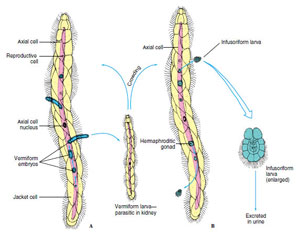Phylum Mesozoa
Phylum Mesozoa
The name Mesozoa (mes-o-zo´a) (Gr. mesos, in the middle, + zoon, animal) was coined by an early investigator (van Beneden, 1876) who believed that the group was a “missing link” between protozoa and metazoa. These minute, ciliated, wormlike animals represent an extremely simple level of organization. All mesozoans live as parasites in marine invertebrates, and the majority of them are only 0.5 to 7 mm in length. Most are composed of only 20 to 30 cells arranged basically in two layers. The layers are not homologous to the germ layers of higher metazoans.
The two classes of mesozoans, Rhombozoa and Orthonectida, differ so much from each other that some authorities place them in separate phyla.
Rhombozoans (Gr. rhombos, a spinning top, + zoon, animal) live in kidneys of benthic cephalopods (bottom- dwelling octopuses, cuttlefishes, and squids). Adults, called vermiforms (or nematogens), are long and slender (Figure 12-1). Their inner, reproductive cells give rise to vermiform larvae that grow and then reproduce. When a population becomes crowded, reproductive cells of some adults develop into gonadlike structures producing male and female gametes. Zygotes grow into minute (0.04 mm) ciliated infusoriform larvae (Figure 12-1B), quite unlike the parent. These larvae are shed with host urine into the seawater. The next part of the life cycle is unknown because infusoriform larvae are not immediately infective to a new host.
Orthonectids (Gr. orthos, straight,
+ nektos, swimming) (Figure 12-2)
parasitize a variety of invertebrates,
such as brittle stars, bivalve molluscs,
polychetes, and nemerteans. Their life
cycles involve sexual and asexual
phases, and the asexual stage is quite
different from that of rhombozoans.
It consists of a multinucleated mass
called a plasmodium, which by division
ultimately gives rise to males and
females.
Phylogeny of Mesozoans
There is still much to learn about these mysterious little parasites, but probably one of the most intriguing questions is the place of mesozoans in the evolutionary picture. Some investigators believe they represent primitive or degenerate flatworms and even place them in phylum Platyhelminthes. Others place them close to some protozoa, possibly ciliates. Whether metazoans and mesozoans derived independently from protozoan beginnings or whether mesozoans are indeed degenerate flatworms is still an enigma.
The name Mesozoa (mes-o-zo´a) (Gr. mesos, in the middle, + zoon, animal) was coined by an early investigator (van Beneden, 1876) who believed that the group was a “missing link” between protozoa and metazoa. These minute, ciliated, wormlike animals represent an extremely simple level of organization. All mesozoans live as parasites in marine invertebrates, and the majority of them are only 0.5 to 7 mm in length. Most are composed of only 20 to 30 cells arranged basically in two layers. The layers are not homologous to the germ layers of higher metazoans.
The two classes of mesozoans, Rhombozoa and Orthonectida, differ so much from each other that some authorities place them in separate phyla.
Rhombozoans (Gr. rhombos, a spinning top, + zoon, animal) live in kidneys of benthic cephalopods (bottom- dwelling octopuses, cuttlefishes, and squids). Adults, called vermiforms (or nematogens), are long and slender (Figure 12-1). Their inner, reproductive cells give rise to vermiform larvae that grow and then reproduce. When a population becomes crowded, reproductive cells of some adults develop into gonadlike structures producing male and female gametes. Zygotes grow into minute (0.04 mm) ciliated infusoriform larvae (Figure 12-1B), quite unlike the parent. These larvae are shed with host urine into the seawater. The next part of the life cycle is unknown because infusoriform larvae are not immediately infective to a new host.
  |
| Figure 12-1 Two methods of reproduction by mesozoans. A, Asexual development of vermiform larve from reproductive cells in the axial cell of the adult. B, Under crowded conditions in the host kidney, reproductive cells develop into gonads with gametes that produce infusoriform dispersal larvae that emerge in the host urine. |
 |
| Figure 12-2 A, Female and, B, male orthonectid (Rhopalura). This mesozoan parasitizes such forms as flatworms, molluscs, annelids, and brittle stars. The structure is a single layer of ciliated epithelial cells surrounding an inner mass of sex cells. |
Phylogeny of Mesozoans
There is still much to learn about these mysterious little parasites, but probably one of the most intriguing questions is the place of mesozoans in the evolutionary picture. Some investigators believe they represent primitive or degenerate flatworms and even place them in phylum Platyhelminthes. Others place them close to some protozoa, possibly ciliates. Whether metazoans and mesozoans derived independently from protozoan beginnings or whether mesozoans are indeed degenerate flatworms is still an enigma.




